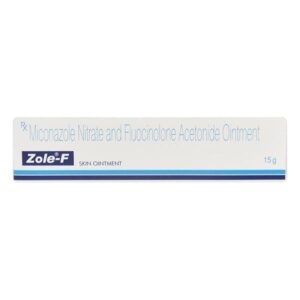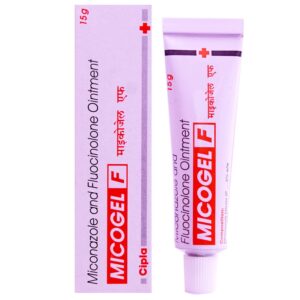MICONAZOLE + FLUOCINOLONE
Miconazole: Miconazole is an antifungal medication used to treat various fungal infections, particularly those affecting the skin and mucous membranes. It belongs to the azole antifungal class of drugs.
The mechanism of action of miconazole involves inhibiting the synthesis of ergosterol, a key component of the cell membrane in fungi. By disrupting the cell membrane, miconazole prevents the growth and spread of fungal organisms.
Miconazole is available in various forms, including creams, powders, sprays, and vaginal suppositories. The specific dose and duration of treatment depend on the type and severity of the fungal infection. It is important to follow the instructions provided by a healthcare professional or the product label.
Common side effects of miconazole may include local skin irritation, itching, burning, or redness at the application site. These side effects are usually mild and temporary. In rare cases, miconazole can cause allergic reactions, such as hives, swelling, or difficulty breathing. If any severe or persistent side effects occur, it is important to seek medical attention.
Miconazole is generally safe and effective when used as directed. However, it may interact with certain medications or medical conditions. It is essential to inform a healthcare professional about any other medications, supplements, or health conditions before using miconazole to ensure safe and effective treatment.
Fluocinolone: Fluocinolone is a synthetic corticosteroid medication that is used for the treatment of various skin conditions. It is available in different forms, such as creams, ointments, gels, and scalp solutions.
The mechanism of action of fluocinolone involves its strong anti-inflammatory properties. It works by inhibiting the production of inflammatory mediators and reducing the activity of immune cells involved in the inflammatory response. This helps to relieve symptoms such as redness, swelling, itching, and discomfort associated with various skin conditions.
The dose of fluocinolone will vary depending on the specific formulation and the condition being treated. It is important to follow the instructions provided by your healthcare professional or as directed on the product label. Typically, a thin layer of the cream, ointment, or gel should be applied to the affected area once or twice daily. For scalp solutions, the solution should be gently massaged into the scalp once daily.
Like all medications, fluocinolone can cause side effects. Common side effects may include skin irritation, burning, itching, dryness, or redness at the site of application. These side effects are usually mild and tend to improve with continued use. However, if they persist or worsen, it is important to inform your healthcare provider.
In rare cases, more serious side effects may occur, such as thinning of the skin, changes in skin color, excessive hair growth, acne, stretch marks, or skin infections. It is important to seek medical attention if you experience any of these side effects.
Fluocinolone should not be used on broken or infected skin, as it may increase the risk of systemic absorption and potentially lead to more serious side effects. It is also important to avoid using fluocinolone for extended periods or in large amounts, as it can increase the risk of systemic side effects.
Keep in mind that fluocinolone is a prescription medication and should be used under the guidance of a healthcare professional. They will be able to provide you with specific instructions and monitor your progress while using this medication.


